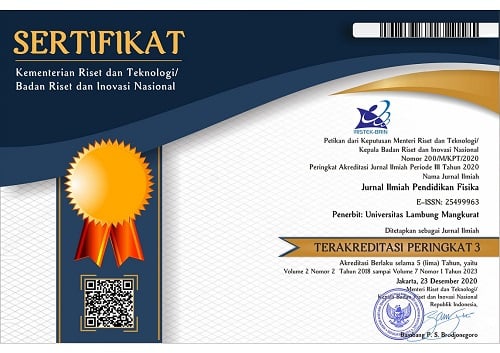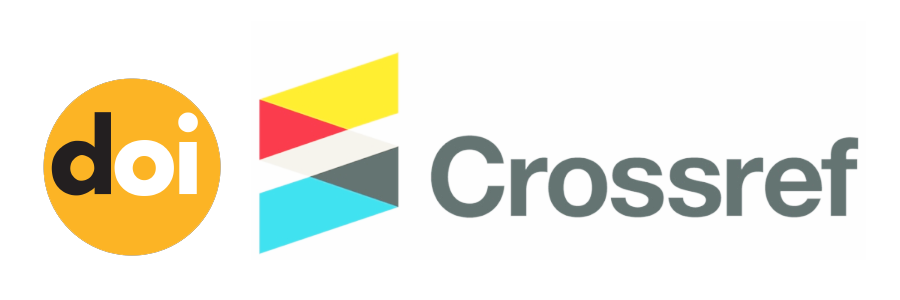Bibliometric Analysis of STEM Robotics in Physics Education: Global Trends (2008-2024) Based on Scopus Data
Abstract
This study aims to analyze global trends in STEM-based robotic physics education through a bibliometric analysis conducted using data obtained from the Scopus database. STEM and robotics are increasingly gaining attention as effective approaches in physics education, aligning with the 21st-century demand for technical skills, creativity, and problem-solving abilities. This research utilizes R bibliometric software to identify publication patterns, researcher collaborations, and key trends in STEM-based robotic physics education from 2008 to 2024. The methods involved searching for articles using the keywords "STEM AND robotic AND physics AND education," resulting in 53 downloaded and analyzed articles. The analysis was conducted in two main steps: data collection from Scopus and metadata analysis to identify research trends and collaboration networks among researchers. The results indicated a substantial growth in the volume of publications and international collaborations, with the United States leading in publication contributions, followed by Ukraine and Colombia. The key findings reveal that recent research trends focus on learning media and STEM. Meanwhile, topics that have received less attention include the impact of STEM on the curriculum and the development of critical thinking skills. Several topics, such as augmented reality and critical thinking, were also identified as challenging potential avenues for future research. This research offers significant guidance for future researchers in developing more effective STEM-based education strategies and suggests closer collaboration between academics and practitioners in various countries. Future research is recommended to explore alternative bibliometric analysis tools and expand the database coverage to enrich perspectives and enhance the scope of findings.
Keywords
Full Text:
PDFReferences
Aleksandrova, N. S., Sokolova, E. G., Kosarenko, N. N., Ibragimova, E. M., Budkevich, R. L., & Yagudina, R. I. (2024). Exploring the frontiers: a comprehensive bibliometric analysis of robotics in science education. Eurasia Journal of Mathematics, Science and Technology Education, 20(10). https://doi.org/10.29333/ejmste/15432
Ameen, N., Hosany, S., & Tarhini, A. (2021). Consumer interaction with cutting-edge technologies: implications for future research. Computers in Human Behavior, 120, 106761. https://doi.org/10.1016/j.chb.2021.106761
Anwar, S., Bascou, N. A., Menekse, M., & Kardgar, A. (2019). A systematic review of studies on educational robotics. Journal of Pre-College Engineering Education Research, 9(2), 19–42. https://doi.org/10.7771/2157-9288.1223
Barredo Arrieta, A., Díaz-Rodríguez, N., Del Ser, J., Bennetot, A., Tabik, S., Barbado, A., Garcia, S., Gil-Lopez, S., Molina, D.,
Benjamins, R., Chatila, R., & Herrera, F. (2020). Explainable artificial intelligence (xai): Concepts, taxonomies, opportunities and challenges toward responsible ai. Information Fusion, 58, 82–115. https://doi.org/10.1016/j.inffus.2019.12.012
Behnamnia, N., Kamsin, A., Ismail, M. A. B., & Hayati, A. (2020). The effective components of creativity in digital game-based learning among young children: a case study. Children and Youth Services Review, 116, 105227.
https://doi.org/10.1016/j.childyouth.2020.105227
Brougham, D., & Haar, J. (2018). Smart technology, artificial intelligence, robotics, and algorithms (stara): employees’ perceptions of our future workplace. Journal of Management and Organization, 24(2), 239–257. https://doi.org/10.1017/jmo.2016.55
Budiyanto, C., Fitriyaningsih, R. N., Kamal, F., Ariyuana, R., & Efendi, A. (2020). Hands-on learning in stem: revisiting educational robotics as a learning style precursor. Open Engineering, 10(1), 649–657. https://doi.org/10.1515/eng-2020-0071
Büyükkidik, S. (2022). A bibliometric analysis: a tutorial for the bibliometrix package in r using irt literature. Journal of Measurement and Evaluation in Education and Psychology, 13(3), 164–193. https://doi.org/10.21031/epod.1069307
Chen, W., Liu, W., Geng, Y., Brown, M. T., Gao, C., & Wu, R. (2017). Recent progress on emergy research: a bibliometric analysis. Renewable and Sustainable Energy Reviews, 73(february), 1051–1060. https://doi.org/10.1016/j.rser.2017.02.041
Ching, Y. H., Yang, D., Wang, S., Baek, Y., Swanson, S., & Chittoori, B. (2019). Elementary school student development of stem attitudes and perceived learning in a stem integrated robotics curriculum. Techtrends, 63(5), 590–601. https://doi.org/10.1007/s11528-019-
-0
Darmawansah, D., Hwang, G. J., Chen, M. R. A., & Liang, J. C. (2023). Trends and research foci of robotics-based stem education: A systematic review from diverse angles based on the technology-based learning model. International Journal of Stem Education, 10(1). https://doi.org/10.1186/s40594-023-00400-3
Dwivedi, Y. K., Hughes, L., Ismagilova, E., Aarts, G., Coombs, C., Crick, T., Duan, Y., Dwivedi, R., Edwards, J., Eirug, A., Galanos, V., Ilavarasan, P. V., Janssen, M., Jones, P., Kar, A. K., Kizgin, H., Kronemann, B., Lal, B., Lucini, B., … Williams, M. D. (2021). Artificial intelligence (ai): multidisciplinary perspectives on emerging challenges, opportunities, and agenda for research, practice and policy. International Journal of Information Management, 57. https://doi.org/10.1016/j.ijinfomgt.2019.08.002
El-Hamamsy, L., Chessel-Lazzarotto, F., Bruno, B., Roy, D., Cahlikova, T., Chevalier, M., Parriaux, G., Pellet, J. P., Lanarès, J., Zufferey, J. D., & Mondada, F. (2021). A computer science and robotics integration model for primary school: Evaluation of a large-scale in-service k-4 teacher-training program. Education And Information Technologies, 26(3). https://doi.org/10.1007/s10639-020-10355-5
Ferrarelli, P., & Iocchi, L. (2021). Learning newtonian physics through programming robot experiments. Technology, Knowledge and Learning, 26(4).
https://doi.org/10.1007/s10758-021-09508-3
Haleem, A., Javaid, M., Qadri, M. A., & Suman, R. (2022). Understanding the role of digital technologies in education: a review. Sustainable Operations and Computers, 3, 275–285. https://doi.org/10.1016/j.susoc.2022.05.004
Ioannou, A., & Makridou, E. (2018). Exploring the potentials of educational robotics in the development of computational thinking: A summary of current research and practical proposal for future work. Education and Information Technologies, 23(6), 2531–2544. https://doi.org/10.1007/s10639-018-9729-z
Kayan-Fadlelmula, F., Sellami, A., Abdelkader, N., & Umer, S. (2022). A systematic review of stem education research in the gcc countries: Trends, gaps and barriers. international Journal of Stem Education, 9(1). https://doi.org/10.1186/s40594-021-00319-7
Khine, M. S. (2017). Robotics in stem education Berlin, Germany: Springer.
https://doi.org/10.1007/978-3-319-57786-9
Lin, Y. T., Wang, M. T., & Wu, C. C. (2019). Design and implementation of interdisciplinary stem instruction: Teaching programming by computational physics. Asia-Pacific Education Researcher, 28(1), 77–91. https://doi.org/10.1007/s40299-018-0415-0
Lu, W., Huang, S., Yang, J., Bu, Y., Cheng, Q., & Huang, Y. (2021). Detecting research topic trends by author-defined keyword frequency. Information Processing and Management, 58(4). https://doi.org/10.1016/j.ipm.2021.102594
Manuel, E. G. C. (2022). Analysis to reduce work-related musculoskeletal disorders.
Menkhoff, T., Kan, S. N., Tan, E. K. B., & Foong, S. (2022). Future-proofing students in higher education with unmanned aerial vehicles technology: A knowledge management case study. Knowledge Management And E-Learning, 14(2), 223–244.
https://doi.org/10.34105/j.kmel.2022.14.013
Ngugi, M. P., Maina, M. C., & Byrne, A. P. (2023). The impact of robotic activities on secondary school students’ interest in physics in kenya. International Journal of Computer Applications Technology and Research, 12(01), 53–59. https://doi.org/10.7753/ijcatr1201.1008
Nguyen, M., & Mougenot, C. (2022). A systematic review of empirical studies on multidisciplinary design collaboration: findings, methods, and challenges. Design Studies, 81, 1–42. https://doi.org/10.1016/j.destud.2022.101120
Nilimaa, J. (2023). New examination approach for real-world creativity and problem-solving skills in mathematics. Trends in Higher Education, 2(3), 477–495. https://doi.org/10.3390/higheredu2030028
Ntemngwa, C., & Oliver, J. S. (2018). The implementation of integrated science technology, engineering and mathematics (stem) instruction using robotics in the middle school science classroom. International Journal of Education in Mathematics, Science and Technology, 6(1), 12–40. https://doi.org/10.18404/ijemst.380617
Peña-Ayala, A. (2014). Preface. Studies in Computational Intelligence, 524, 441–466. https://doi.org/10.1007/978-3-319-02738-8
Rashid, T., & Asghar, H. M. (2016). Technology use, self-directed learning, student engagement and academic performance: Examining the interrelations. Computers in Human Behavior, 63, 604–612. https://doi.org/10.1016/j.chb.2016.05.084
Sari, A. K., & Ardianto, D. (2023). Mapping science, technology, engineering, and mathematics (stem) research on physics topics using bibliometric analysis. Amplitudo : Journal of Science and Technology Inovation, 2(1), 1–6.
https://doi.org/10.56566/amplitudo.v2i1.23
Siahaan, J. H., Marson, F., & Forsyth, O. (2022). Transforming primary school science education: The quantum teaching revolution. Jurnal Ilmu Pendidikan Dan Humaniora, 11(1), 35–51. https://doi.org/10.35335/jiph.v11i1.14
Thin, A., Kyaw, Z., & Wang, Z. (2018). Mapping the intellectual structure of the linked data field: A co-word analysis and social network analysis. International Journal of Advancedresearch in Science, Engineering and Technology, 5(8), 6632–6647.
http://scheme.
Thomas, S. (2016). Future ready learning. 2016 National Education Technology Plan, 1–106.
Uden, L., Sulaiman, F., Ching, G. S., & Rosales, J. J. (2023). Integrated science, technology, engineering, and mathematics project-based learning for physics learning from neuroscience perspectives. Frontiers in Psychology, 14, 1–15.
https://doi.org/10.3389/fpsyg.2023.1136246
Wahono, B., & Chang, C. Y. (2019). Assessing teacher’s attitude, knowledge, and application (aka) on stem: an effort to foster the sustainable development of stem education. Sustainability (Switzerland), 11(4). https://doi.org/10.3390/su11040950
Wibowo, F. C., Prahani, B. K., Kurniawan, B. R., Brata, W. W. W., Budhi, H. S., Noor, F. M., Fawaida, U., Jamaludin, D. N., Jalil, M., Ahmad, N. J., Costu, B., & Karlin, K. A. A. (2024). Challenges of STEM approach in physics learning: A bibliometric analysis. AIP Conference Proceedings, 3116(1). https://doi.org/10.1063/5.0210180
Willard, J., Jia, X., Xu, S., Steinbach, M., & Kumar, V. (2022). Integrating scientific knowledge with machine learning for engineering and environmental systems. ACM Computing Surveys, 55(4), 1–34. https://doi.org/10.1145/3514228
Yiğit. (2019). Exploring the Stem readiness level of high schools in ankara. August.
Zhang, D., Wang, J., Jing, Y., & Shen, A. (2024). The impact of robotics on STEM education: Facilitating cognitive and interdisciplinary advancements. Applied and Computational Engineering, 69(1), 7–12. https://doi.org/10.54254/2755-2721/69/20241433
Zhang, L., & Eichmann-Kalwara, N. (2019). Mapping the scholarly literature found in scopus on research data management: A bibliometric and data visualization approach. Journal of Librarianship and Scholarly Communication, 7(1), 0–19. https://doi.org/10.7710/2162-3309.2266
DOI: https://doi.org/10.20527/jipf.v8i3.13894
Refbacks
- There are currently no refbacks.
Indexed by: Jurnal Ilmiah Pendidikan Fisika is licensed under a creative commons attribution-share alike 4.0 international license
Statistics Counter |

















